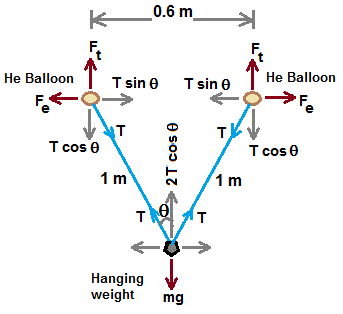
Figure shows the forces acting on hanging weight and the Balloons.
Fe is the repulsive electrostatic force acting on the charged baloons .
Ft is the upthrust experienced by baloons due to bouyancy. Tension forces acting on the strings is also shown in figure.
It can be seen from figure, net vertical component of Tension is balanced by weight of the hanging mass.
Hence we have, 2 T cosθ = m g or T = mg / (2 cosθ) ...................(1)
at He balloon, horizontal component of Tension is balanced by electrostatic force,
Hence we have, Fe = T sinθ .................(2)
Using eqn.(1), Eqn.(2) is written as, Fe = .........................(3)
.........................(3)
where q is the charge on each balloon, m is mass of hanging object, r is the distance between balloon,
g is acceleration due to gravity, ε0 is the permitivity of free space.
we can see from figure, tanθ =
By substituting all the values in eqn.(3), we get q = 5.5×10-7 C
(distance between balloons is assumed as 0.6 m, not 0.6 cm as shown in figure.
0.6 cm or 6 mm distance between balloons, precisely between centres of balloons, is negligibly small distance , practically not possible )




 myCBSEguide
myCBSEguide

Gaurav Seth 6 years, 4 months ago
Figure shows the forces acting on hanging weight and the Balloons.
Fe is the repulsive electrostatic force acting on the charged baloons .
Ft is the upthrust experienced by baloons due to bouyancy. Tension forces acting on the strings is also shown in figure.
It can be seen from figure, net vertical component of Tension is balanced by weight of the hanging mass.
Hence we have, 2 T cosθ = m g or T = mg / (2 cosθ) ...................(1)
at He balloon, horizontal component of Tension is balanced by electrostatic force,
Hence we have, Fe = T sinθ .................(2)
Using eqn.(1), Eqn.(2) is written as, Fe = .........................(3)
.........................(3)
where q is the charge on each balloon, m is mass of hanging object, r is the distance between balloon,
g is acceleration due to gravity, ε0 is the permitivity of free space.
we can see from figure, tanθ =
By substituting all the values in eqn.(3), we get q = 5.5×10-7 C
(distance between balloons is assumed as 0.6 m, not 0.6 cm as shown in figure.
0.6 cm or 6 mm distance between balloons, precisely between centres of balloons, is negligibly small distance , practically not possible )
1Thank You